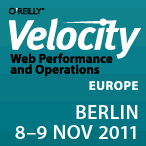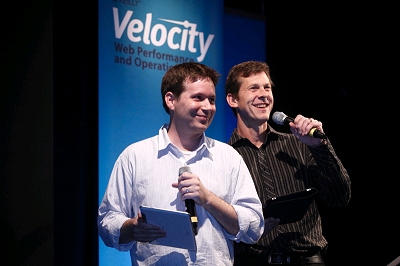Velocity Europe 2011 conference report
Wednesday, November 30, 2011
Velocity Europe 2011 conference report
Web companies, big and small, face the same challenges. Our pages must be fast, our infrastructure must scale up (and down) efficiently, and our sites and services must be reliable … without burning out the team.
Velocity Europe conference Website
 Three years after its inception in California O’Reilly’s Velocity Web Performance and Operations Conference finally made it to Europe. Some 500 people, web developers, architects, system administrators, hackers, designers, artists, got together at Velocity Europe in Berlin on November 8 and 9 to learn about the latest developments in web performance optimization and managing web infrastructure, exchange ideas and meet vendors in the exhibition hall.
Three years after its inception in California O’Reilly’s Velocity Web Performance and Operations Conference finally made it to Europe. Some 500 people, web developers, architects, system administrators, hackers, designers, artists, got together at Velocity Europe in Berlin on November 8 and 9 to learn about the latest developments in web performance optimization and managing web infrastructure, exchange ideas and meet vendors in the exhibition hall.
Velocity Europe was well organized and run. There were power strips everywhere and a dedicated wireless network for the participants, although the latter barely handled the load when everyone was hogging for bandwidth. Seeing bytes trickling in slowly at a performance conference was not without irony. Some things never change: Getting connected sometimes requires patience and endurance. Back in the days I was volunteering at the W3C conferences preparation involved running cables and configuring the “Internet access room”, only then contention for network resources meant waiting for an available computer.
As expected for a techie conference, about the only people wearing jackets and ties were the AV operators, food was plentiful and good, and the sponsors handed out T-shirts, caps, and other give-aways. Plenary sessions were recorded and streamed live, and #velocityconf on Twitter also has a good collection of facts and memorable quotes for those who couldn’t attend in person.

Steve Souders and John Allspaw led through two busy days packed with plenary sessions, lighting talks and two parallel tracks on Web performance and Web operations. While bits and bytes certainly mattered to the speakers and the audience, the focus was clearly on improving the Web experience for users and the business aspects of fast and well-managed Web sites.
The conference started with a controversial talk about building a career in Web operations by Theo Schlossnagle, and I couldn’t agree more with many of his observations, from suggesting discipline and patience (and recommending martial arts to develop those virtues), learning from mistakes, developing with operations in mind to seeing security not as a feature but a mentality, a state of mind. Along the same lines, Jon Jenkins later talked about the importance of dev ops velocity, why it’s important to iterate fast, deploy fast, and learn from mistakes quickly, mentioning the OODA loop. Some of the Amazon.com deployment stats are just mind-boggling: 11.6 seconds mean time between deployments, and over 1,000 deployments in a single hour to thousands of hosts.
Joshua Bixby addressed the relationship between faster mobile sites and business KPIs. Details of the tests conducted and the short-term and long-term effects on visitor behaviour are also available in his recent blog post about a controlled performance degradation experiment conducted by Strangeloop. Another interesting observation was the strong preference of customers for the full Web sites over mobile versions and native apps: One retailer in the U. S. found that of the online revenue growth for that company was driven by the full site. 35% of the visitors on their mobile site clicked through to the full site immediately, 24% left on page 1, another 40% left after page 1, and only 1% bought something.
Performance also matters at Betfair, one of the world’s largest betting providers. Doing cool stuff is important too, but according to Tim Morrow’s performance pyramid of needs that’s not where you start:
- It works.
- It’s fast.
- It’s useful. (I personally have a slight preference for useful over fast.)
- It’s cool.
Jeffrey Veen of Hotwired, Adaptive Path, TypeKit fame kicked off the second day with an inspiring talk on designing for disaster, working through crises and doing the impossible. I liked the fancy status boards on the walls, and the “CODE YELLOW” mode, the openness and the clear roles when something bad happens. And something bad will happen, as John Allspaw pointed out: “You will reach the point of compensation exhausted, systems, networks, staff, and budgets.” A helpful technique for planning changes is to write down the assumptions, expectated outcomes and potential failures individually, and then consolide results as a group and look for discrepancies. If things still go wrong, Michael Brunton-Spall and Lisa van Gelder suggested to stay calm, isolate failing components, and reduce functionality to the core. Having mechanisms in place to easily switch on and off optional features is helpful, down to “page pressing” to produce static copies of the most frequently requested content to handle peak loads.
Several talks covered scripting performance and optimization techniques. Javascript is already getting really fast, as David Mandelin pointed out, running everything from physics engines to an H.264 decoder at 30 fps, as long as we avoid sparse arrays and the slow eval statements and with blocks. Using proven libraries is generally a good idea and results in less code and good cross-browser compatibility, but Aaron Peters made the point that using jQuery (or your favorite JavaScript library) for everything may not be best solution, and accessing the DOM directly when it’s simple and straightforward can be a better choice. Besides that, don’t load scripts if the page doesn’t need them – not that anyone would ever do that, right? – and then do waterfall chart analysis, time and again. Mathias Bynens added various techniques for reducing the number of accesses to the DOM, function calls and lookups with ready-to-use code snippets for common tasks.
For better mobile UI performance, Estelle Weyl suggested inlining CSS and JS on the first page, using data: URLs and extracting and saving resources in LocalStorage. Power Saving Mode (PSM) for Wi-fi and Radio Resource Control (RRC) for cellular are intended to increase battery life but have the potential to degrade perceived application performance as subsequent requests will have to wait for the network reconnection. Jon Jenkins explained the split browser architecture of Amazon Silk, which can use proxy servers on Amazon EC2 for compression, caching and predictive loading to overcome some of these performance hogs.
IBM’s Patrick Mueller showed WEINRE (WEb INspector REmote) for mobile testing, a component of the PhoneGap project.
Google has been a strong advocate for a faster Web experience and long offered tools for measuring and improving performance. The Apache module mod_pagespeed will do much of the heavy lifting to optimize web performance, from inlining small CSS files to compressing images and moving metadata to headers. Andrew Oates also revealed Google’s latest enhancements to Page Speed Online, and gave away the secret parameter to access the new Critical Path Explorer component. Day 2 ended with an awesome talk by Bradley Heilbrun about what it takes to run the platform that serves “funny cat videos and dogs on skateboards”. Bradley had been the first ops guy at YouTube, which once started with five Apache boxes hosted at Rackspace. They have a few more boxes now.
With lots of useful information, real world experiences and ideas we can apply to our Websites, three books signed by the authors and conference chairs, High Performance Web Sites and Even Faster Web Sites, and Web Operations: Keeping the Data On Time, stickers, caps and cars for the kids, Velocity Europe worked great for me. The next Velocity will be held in Santa Clara, California in June next year, and hopefully there will be another Velocity Europe again.
Related links
Photo credit: O´Reilly
Labels: events, javascript, metrics, networking, technology, webdevelopment